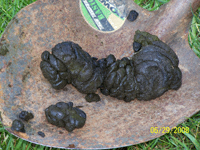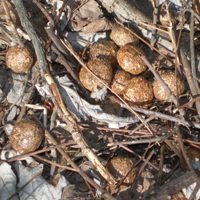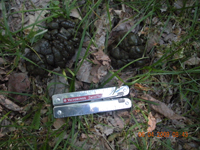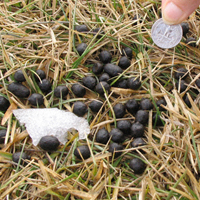The Seattle Parks Department gave our Greenbelt Restoration Project a job box that contains the tools we need to clear the land in our Greenbelt restoration site. That box is chained to one of the large cedar trees on the property.

Several weeks ago, I noticed that an animal was defecating near the base of that tree. Over the week, the pile grew. I wondered if a cat was using that spot for its personal litter box. I thought about cleaning it up but didn’t.
One day, another forest steward noticed the pile and commented. She thought it had been left by something bigger than a cat and wondered if it was droppings from a deer. Earlier in the week, someone had asked me if we had ever seen deer on the site. I said “No.” I loved the idea but wonder if deer could live in the inner city and stay safe.
After this interaction, it occurred to me that not only was the poop pile unsightly, it was also disrespectful to the tree. I cleaned it up and buried the feces. The next morning, there were two more piles. One had an unusual consistency and I wondered if the animal had diarrhea. (The two photos below were taken a day later so the feces were no longer fresh.)


Aside from being irritated that my effort to clean the area hadn’t done any good, I was curious. I wanted to find out what animal was leaving these droppings. It was time to investigate.
I found a Scat ID section on the Internet Center for Wildlife Damage Management (ICWDM) website. ICWDM is “a non-profit, grant-funded site that provides research-based information on how to handle wildlife damage problems responsibly.” (The next series of photos were used with ICWDM’s permission.)





The description offered by the ICWDM said:
Raccoon (Procyon lotor): Droppings are 2 to 3 inches long and 1/2 inch wide. You often can identify what a raccoon recently has been eating. Corn kernels or fruit may be visible, for example. Droppings frequently are found in piles, called latrines, on roofs, in attics, in sandboxes, or open areas. Raccoons defecate in the same location.
Ah ha….. I hadn’t noticed anything peculiar about the first droppings but the last set were full of seeds/pits. Since there are big cherry trees on the property, and the cherry’s are ripe and falling, the animal had more than likely been eating cherries. My conclusion was that the pile was probably left by a raccoon, possibly a raccoon with diarrhea from eating too many cherries!
Realizing that the animal may have been a raccoon brought back memories; memories of standing on the land that is now Greenbelt, holding Sreejit as an infant, with a raccoon chasing our dog around and around me; memories of coming out to the tree-house that I had slept in April to October for five years only to find two big raccoons standing on their hind legs between me and it (that was the end of my sleeping in the tree house); memories of four raccoons, which are usually nocturnal, crossing my yard in broad daylight.
I haven’t seen a raccoon in this area for a decade. I like the idea of them, along with other wildlife, returning to the Greenbelt, but I hope that their activity is at night. And I’m glad that this land has mostly been cleared so it is likely they would choose a less visible site to sleep. Regardless, I am clearly being presented with the opportunity to work on my past fear.
Back to the story at hand…. scat, feces, poop, defecation, droppings…
Who would have thought that I would ever be investigating and blogging about “poop.” My life has taken an interesting turn… and I love it!


